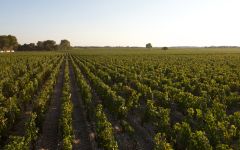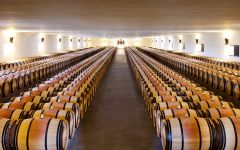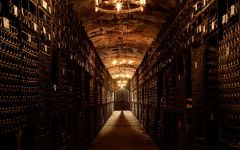Chateau Mouton Rothschild 2020
-
James
Suckling -
Robert
Parker - Decanter
-
Wine
Enthusiast -
Jeb
Dunnuck




Product Details
Your Rating
Somm Note
Winemaker Notes
The wine is a deep, dark, garnet-hued cherry red. The refined and complex nose opens on remarkably ripe black fruit aromas, going on with airing to reveal blackcurrant and aniseed notes combined with touches of graphite and a subtle hint of blond tobacco. From a smooth yet full-bodied attack, the palate displays highly precise tannins which sustain an expansion of flavors in harmonious, succulent balance. Nuanced refinements evident in touches of mint and mineral, smoky notes.
Blend: 84% Cabernet Sauvignon, 13% Merlot, 2% Cabernet Franc, 1% Petit Verdot
About the Label Artwork
A British painter of Scottish origin who divides his time between London and Trinidad, Peter Doig is the artist chosen by Château Mouton Rothschild to create the original artwork to illustrate the label for its 2020 vintage.
In his work for the label, the painter combines echoes of Cezanne and van Gogh with a fascinating personal reverie on the nocturnal birth of a great wine, seemingly brought to life by the strange magic of a song played on the guitar.
The painting is a dreamscape. The artist has sought to create a picture that celebrates the growing and harvesting of grapes, showing workers in the vineyard. Peter Doig wished to establish a connection with artists like Millet, van Gogh and Bacon who had depicted vineyard or farm workers. The work also had a personal inspiration in his Trinidadian friend, an artist known as Embah (Emheyo Bhabba) who brought a cuatro - a four string guitar - to one of Dog's exhibitions in Paris and shared his music and poetry during the course of the evening.
"The painting shows something of what goes on behind the scenes in the production of wine, what happens offstage, as it were. It's a sort of ode to workers, to all those involved at the various stages of making a wine before it's finally bottled. It's a dream with a romantic streak, as if someone spontaneously decided to sing in the vines. It's a moment of poetry, where you can take your time. It's neither really day nor really night, but rather something in between, between waking and sleeping. It is possible to see it as a progression, a dream journey in the world of the harvest." Peter Doig.
Julien de Beaumarchais de Rothschild, co-owner of Château Mouton Rothschild with responsibility for the estate's artistic and cultural activity and relations with the artist who creates the original artwork for the label of each new vintage, explains: "We wanted an artist who uses canvas and pictorial material to express figurative subjects. Unrivalled as a colourist, Peter Dog focuses entirely on painting and has become one of his generation's foremost exponents of the discipline, holding exhibitions all over the world. There is something very special about his technique and his universe that sets them apart in contemporary figurative art. His subjects are very varied, his painting resists any classification: he has succeeded in creating his own, inimitable world."
Professional Ratings
-
James Suckling
The purity of blackcurrants, blueberries, creme de cassis, and flowers. Hints of subtle spearmint. Iron. Blood orange. Medium-bodied with a compacted palate, like a cylinder of perfectly ripe fruit and fine tannins. A million layers of tight-grained tannins. It goes on and on. Such freshness and weightlessness to it. Ethereal. New classicism. Modern take on the 1986.
-
Robert Parker's Wine Advocate
The 2020 Mouton Rothschild is a striking wine and one that I regretted not purchasing en primeur as soon as it landed in my glass. Offering up complex aromas of minty cassis, pencil shavings, loamy soil, cigar wrapper, espresso roast and violets, it's medium to full-bodied, broad and layered, with terrific concentrated, beautifully refined tannins and a long, penetrating finish. Checking in at 12.8% alcohol, its incipient complexity, ineffable sense of completeness and exquisite balance mark it out as the purists' choice among the trio of 2018, 2019 and 2020. In this vintage, the lots that made it into the blend were largely confined to the core gravel terroirs that represent Mouton's heart, meaning that there's a little less to go around. This was the first vintage overseen by Mouton's new technical director, Jean-Emmanuel Danjoy, and he has begun with a flying start.
-
Decanter
Dark fruits on the nose, blackcurrants and cherries with savoury nuances of dark chocolate and tobacco. Fresh and forward on the palate, this hits you square on, still very lean and direct, almost piercing and severe in its intensity and drive, though wonderfully precise: it’s like an arrow. Serious and focussed yet full and layered, the texture is lovely, a slight graininess that lingers but it’s the acidity and the fruit purity that are so excellent - they give such a sense of vibrancy and make this wine so thrilling. You get a feeling of pent-up energy, but after a few minutes the slight density of the ripe fruit comes through, giving some plushness and weight. I love the Cabernet details and the mineral element that leaves the mouth cool and fresh. A well constructed, subtle beauty.
-
Wine Enthusiast
This is a massive, impressive wine. Dense tannins and succulent black fruits are the outward manifestation of the hidden power of this concentrated wine. The fruit is opulent, full of possibility.
-
Jeb Dunnuck
The 2020 Chateau Mouton Rothschild is in the running for the biggest, baddest, and most concentrated wine in the vintage. Based on 84% Cabernet Sauvignon, 13% Merlot, 2% Cabernet Franc, and 1% Petite Verdot brought up in new barrels, this inky hued beast of wine offers up classic Mouton ripe black fruits, scorched earth, tobacco leaf, and freshly sharpened pencil-like aromatics. These carry to a full-bodied, concentrated, tannic, backward 2020 with terrific purity, building, mouth-coating tannins, terrific balance, and one gorgeous finish. Unfortunately, as with many of the top 2020s, this isn't for those looking for instant gratification, and a decade (or more) of cellaring is advised. This hit 13.1% natural alcohol with a pH of 3.78. It will be a 50-, 60-, 70+-year wine.
Other Vintages
2022-
Jeb
Dunnuck -
Robert
Parker -
James
Suckling - Decanter
-
Wine
Enthusiast -
James
Suckling - Decanter
-
Jeb
Dunnuck -
Robert
Parker
-
Wine
Enthusiast -
James
Suckling -
Jeb
Dunnuck -
Wine
Spectator -
Robert
Parker - Decanter
-
James
Suckling - Decanter
-
Wine
Enthusiast -
Robert
Parker -
Wine
Spectator -
Jeb
Dunnuck
-
James
Suckling -
Wine
Spectator - Decanter
-
Robert
Parker -
Jeb
Dunnuck -
Wine
Enthusiast
-
Robert
Parker -
Jeb
Dunnuck -
James
Suckling - Decanter
-
Wine
Spectator -
Wine
Enthusiast
-
Jeb
Dunnuck -
James
Suckling -
Wine
Enthusiast - Decanter
-
Robert
Parker -
Wine
Spectator
-
James
Suckling -
Jeb
Dunnuck -
Wine
Spectator -
Wine
Enthusiast - Decanter
-
Robert
Parker
-
Wine
Enthusiast -
James
Suckling -
Wine
Spectator -
Robert
Parker
-
Wine
Enthusiast -
James
Suckling -
Robert
Parker -
Wilfred
Wong -
Wine
Spectator
-
James
Suckling -
Robert
Parker -
Wine
Spectator -
Wine
Enthusiast
- Decanter
-
Wilfred
Wong -
James
Suckling -
Wine
Spectator -
Wine
Enthusiast -
Robert
Parker
-
Robert
Parker - Decanter
-
Wine
Spectator -
James
Suckling -
Wine
Enthusiast
-
Jeb
Dunnuck - Decanter
-
Wine
Enthusiast -
Robert
Parker -
James
Suckling -
Wine
Spectator
-
Wine
Enthusiast - Decanter
-
Wine
Spectator -
Jeb
Dunnuck
-
Wine
Enthusiast -
Robert
Parker -
James
Suckling -
Wine
Spectator
-
Robert
Parker -
Wine
Spectator -
James
Suckling -
Wilfred
Wong -
Wine
Enthusiast
-
Wine
Spectator -
Wine &
Spirits -
Robert
Parker
-
Robert
Parker -
Wine
Spectator -
Wine
Enthusiast -
James
Suckling
-
Robert
Parker -
Wine
Spectator -
James
Suckling
-
Wine
Spectator
-
Wine
Enthusiast -
Robert
Parker -
Wine &
Spirits -
Wine
Spectator -
James
Suckling
-
Robert
Parker -
Wine
Spectator
-
Robert
Parker -
Wine &
Spirits -
Wine
Spectator -
James
Suckling
-
Wine &
Spirits -
Robert
Parker
- Decanter
-
Robert
Parker -
Wine
Spectator -
James
Suckling
-
Wine
Spectator -
Robert
Parker -
James
Suckling
-
Wine
Spectator -
Robert
Parker -
James
Suckling
-
James
Suckling -
Wine
Spectator -
Robert
Parker
-
James
Suckling -
Robert
Parker
-
James
Suckling - Decanter
-
Wine
Spectator -
Robert
Parker
-
James
Suckling -
Wine
Spectator
-
Robert
Parker - Decanter
-
Wine
Spectator
-
James
Suckling - Decanter
-
Robert
Parker
-
Wine
Spectator
-
Wine
Spectator -
James
Suckling -
Robert
Parker
-
Jeb
Dunnuck -
James
Suckling -
Robert
Parker -
Wine
Spectator - Decanter
-
Wine
Spectator
-
James
Suckling -
Robert
Parker
-
Wine
Spectator
-
Robert
Parker
-
James
Suckling -
Robert
Parker -
Wine
Spectator








A First Classified Growth, Château Mouton Rothschild spans 82 hectares (202 acres) of vines at Pauillac in the Médoc, planted with the classic varieties of the region: Cabernet Sauvignon (79%), Merlot (17%), Cabernet Franc (3 %), Petit Verdot (1 %). The average age of the vines is 50 years.
The estate benefits from exceptionally favourable natural conditions, in the quality of the soil, the position of its vines and their exposure to the sun. Combining respect for tradition with the latest technology, it receives meticulous attention from grape to bottle. The wine is matured in new French oak barrels.
Le Petit Mouton de Mouton Rothschild is the second wine of Château Mouton Rothschild.
The estate also comprises 6 hectares (15 acres) of sandy, gravelly soil planted with Sauvignon Blanc (51%), Semillon (40%) and Sauvignon Gris (9%), used to make its white wine, Aile d’Argent.
Brought to the pinnacle by two exceptional people, Baron Philippe de Rothschild (1902-1988) then his daughter Baroness Philippine (1933-2014), its destiny has now been taken in hand by her three children: Camille and Philippe Sereys de Rothschild, and Julien de Beaumarchais de Rothschild. True to their grandfather’s and mother’s work, all three are committed, with the same enthusiasm and determination, to perpetuating Baron Philippe’s dictum: “Live for the vine”. Almost a command, it means being there for the vineyard in good times and in hardship, serving it with skill and honouring it with art.
Château Mouton Rothschild is a place of art and beauty, famous for the spectacular vista of its great barrel hall, its remarkable vat room and its Museum of Wine in Art. Every year since 1945, the Château Mouton Rothschild label has been illustrated with an original artwork by a great contemporary artist. Dalí, César, Miró, Chagall, Warhol, Soulages, Bacon, Balthus, Tàpies, Koons and Doig are only some of the artists featured in a fascinating collection to which a new work is added each year and which makes up the Paintings for the Labels exhibition.

One of the world’s most classic and popular styles of red wine, Bordeaux-inspired blends have spread from their homeland in France to nearly every corner of the New World. Typically based on either Cabernet Sauvignon or Merlot and supported by Cabernet Franc, Malbec and Petit Verdot, the best of these are densely hued, fragrant, full of fruit and boast a structure that begs for cellar time. Somm Secret—Blends from Bordeaux are generally earthier compared to those from the New World, which tend to be fruit-dominant.

The leader on the Left Bank in number of first growth classified producers within its boundaries, Pauillac has more than any of the other appellations, at three of the five. Chateau Lafite Rothschild and Mouton Rothschild border St. Estephe on its northern end and Chateau Latour is at Pauillac’s southern end, bordering St. Julien.
While the first growths are certainly some of the better producers of the Left Bank, today they often compete with some of the “lower ranked” producers (second, third, fourth, fifth growth) in quality and value. The Left Bank of Bordeaux subscribes to an arguably outdated method of classification that goes back to 1855. The finest chateaux in that year were judged on the basis of reputation and trading price; changes in rank since then have been miniscule at best. Today producers such as Chateau Pontet-Canet, Chateau Grand Puy-Lacoste, Chateau Lynch-Bages, among others (all fifth growth) offer some of the most outstanding wines in all of Bordeaux.
Defining characteristics of fine wines from Pauillac (i.e. Cabernet-based Bordeaux Blends) include inky and juicy blackcurrant, cedar or cigar box and plush or chalky tannins.
Layers of gravel in the Pauillac region are key to its wines’ character and quality. The layers offer excellent drainage in the relatively flat topography of the region allowing water to run off into “jalles” or streams, which subsequently flow off into the Gironde.
